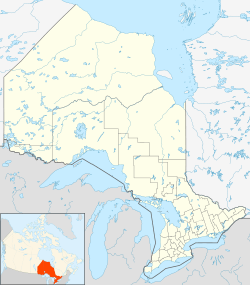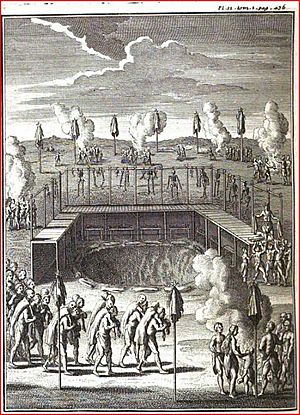Ratcliff Site facts for kids
| Location | Whitchurch–Stouffville, Regional Municipality of York, Ontario, Canada |
|---|---|
| Region | Regional Municipality of York, Ontario |
| Coordinates | 43°59′48″N 79°17′6″W / 43.99667°N 79.28500°W |
| History | |
| Periods | Late Precontact Period, ca. 1550–1615 |
| Cultures | Huron (Wendat) |
The Ratcliff Site, also known as the Baker Hill Site, was a village of the Huron-Wendat people. It was active in the 16th century, long before Europeans settled in the area. This ancient village was located near the Rouge River in what is now Whitchurch–Stouffville, Ontario, Canada. It's about 25 kilometers north of modern-day Toronto.
The village was built on a hill overlooking a steep valley. This spot was likely chosen for protection. Today, a quarry occupies the site. Farms surround the area where the village once stood.
Contents
Discovering the Past
Archaeologists study old sites like Ratcliff to learn about people who lived long ago. They look for artifacts, which are objects made or used by humans. These objects help us understand daily life, tools, and even beliefs of ancient cultures.
What Artifacts Tell Us
Many interesting artifacts were found at the Ratcliff Site in the mid-1800s. These discoveries give us clues about the Huron-Wendat people.
- Tools and Weapons: People found stone axes, flint arrowheads, and spear tips. These were used for hunting, building, and daily tasks.
- Pottery and Pipes: Broken pieces of pottery were common. Many earthen and stone pipes were also found. This shows that pottery making was important.
- Decorations: Animal teeth were used for decoration. Bears' teeth had holes for stringing. Polished teeth from beavers, deer, and moose were also found.
- Bone Tools: Bone needles were used for sewing. Fish-spears made from deer shoulder-blades helped with fishing.
- Food Preparation: Large stones called millstones were found. Women used these to crush corn, a main food source.
- Unique Finds: One human skull was found with seven holes. It was likely kept as a trophy, showing how many enemies the owner had defeated in battle.
Connections to Other Groups
The pottery found at Ratcliff shows that the villagers traded or had contact with other Iroquoian groups. These groups lived in what is now upstate New York and along the St. Lawrence River. The large number of stone tools also suggests the village was a center for making and trading stone objects.
Some artifacts found were from Europe, like black glass and copper beads. These items tell us the village was active between the late 1500s and early 1600s. This was a time when Europeans were just beginning to arrive in North America.
Ancient Burial Traditions
About 400 meters north of the Ratcliff Site, a large burial ground was discovered in the 1840s. It contained "many hundreds" of Huron skeletons. This discovery helps us understand ancient Huron burial customs.
The Huron-Wendat people had a special ceremony called the Feast of the Dead. When someone died, they were first buried in a temporary grave. Every ten years or so, the community would gather the bones from these temporary graves. They would then move all the bones to a large, shared burial pit called an ossuary. This was a very important ceremony that brought communities together.
Village Connections
The people living at the Ratcliff Site likely moved there from another large village called the Mantle Site. The Mantle Site was located about five kilometers southeast of Ratcliff, also in Whitchurch–Stouffville. It was abandoned in the early 1600s.
The Ratcliff Site was also active at the same time as the Aurora Site. The Aurora Site was another Huron-Wendat village located about four kilometers northwest of Ratcliff. Both sites were within the area that is now Whitchurch–Stouffville. This shows that the area was home to several thriving Huron-Wendat communities during this period.



